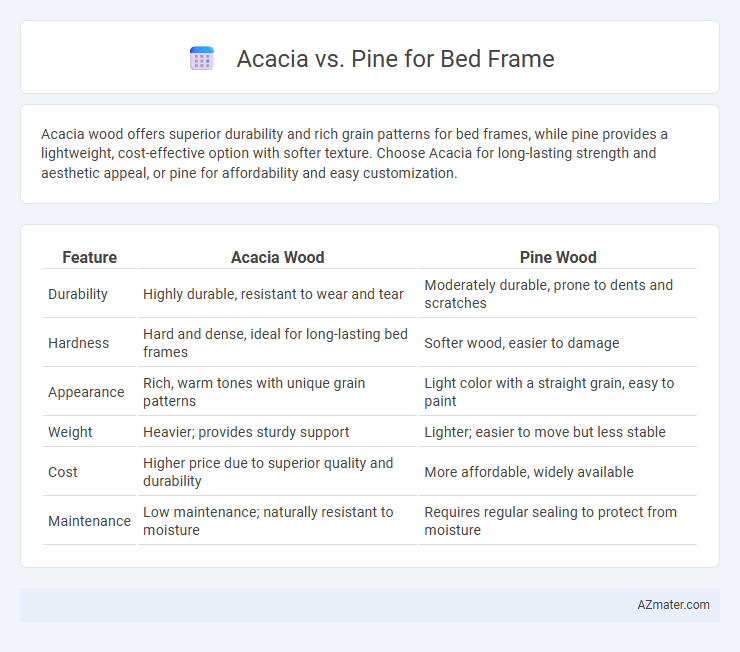Acacia wood offers superior durability and rich grain patterns for bed frames, while pine provides a lightweight, cost-effective option with softer texture. Choose Acacia for long-lasting strength and aesthetic appeal, or pine for affordability and easy customization.
Table of Comparison
| Feature | Acacia Wood | Pine Wood |
|---|---|---|
| Durability | Highly durable, resistant to wear and tear | Moderately durable, prone to dents and scratches |
| Hardness | Hard and dense, ideal for long-lasting bed frames | Softer wood, easier to damage |
| Appearance | Rich, warm tones with unique grain patterns | Light color with a straight grain, easy to paint |
| Weight | Heavier; provides sturdy support | Lighter; easier to move but less stable |
| Cost | Higher price due to superior quality and durability | More affordable, widely available |
| Maintenance | Low maintenance; naturally resistant to moisture | Requires regular sealing to protect from moisture |
Introduction to Acacia and Pine Wood
Acacia wood is a durable hardwood known for its rich, warm tones and natural resistance to moisture and decay, making it a popular choice for robust, long-lasting bed frames. Pine wood, a softwood, offers a lighter color palette and is more affordable while providing adequate strength and easy workability for customizable bed frame designs. Selecting between Acacia and Pine depends on desired aesthetics, durability, and budget considerations.
Key Differences Between Acacia and Pine
Acacia bed frames are known for their dense hardwood structure, offering superior durability and rich natural grain patterns, while pine frames are softer, lightweight, and more prone to dents or scratches. Acacia wood features a higher resistance to moisture and insects, making it ideal for long-lasting furniture, whereas pine requires more maintenance and protective finishes. The cost difference is notable, with acacia typically priced higher than pine due to its strength and aesthetic appeal.
Durability: Acacia vs Pine Bed Frames
Acacia bed frames offer exceptional durability due to their dense, hard grain and natural resistance to decay and insect damage, making them ideal for long-lasting furniture. Pine bed frames, while more affordable and lightweight, are softer and prone to dents or scratches, which can reduce their durability over time. Choosing Acacia ensures a sturdy, robust bed frame that withstands wear better than the more delicate pine alternatives.
Aesthetic Appeal: Grain and Color Comparison
Acacia wood features a rich, varied grain with deep golden to reddish-brown hues, offering a warm and luxurious aesthetic ideal for creating visually striking bed frames. Pine wood displays a lighter color palette with pale yellow to creamy tones and a more uniform, subtle grain pattern, providing a soft and rustic charm suitable for minimalist and farmhouse styles. Choosing between Acacia and Pine depends on the desired visual impact, with Acacia delivering bold elegance and Pine offering understated simplicity.
Cost Comparison: Acacia vs Pine
Acacia wood bed frames typically cost more than pine due to their durability, density, and rich grain patterns, which enhance long-term value and aesthetic appeal. Pine is a budget-friendly option, offering a lightweight and softer material but may require more maintenance and show wear faster, impacting overall cost-effectiveness. Choosing between acacia and pine frames depends on balancing initial investment with durability and visual quality for bedroom furniture.
Sustainability and Environmental Impact
Acacia wood is highly sustainable due to its fast growth rate and natural resistance to pests, making it an eco-friendly choice for bed frames compared to pine. Pine, while renewable, often requires chemical treatments to enhance durability, which can result in a higher environmental footprint. Choosing acacia supports sustainable forestry practices and reduces the need for harmful pesticides, contributing positively to environmental conservation.
Maintenance Requirements for Each Wood
Acacia wood requires regular oiling to maintain its natural luster and protect against moisture, making it moderately high-maintenance compared to pine. Pine is softer and more prone to dents and scratches, but it generally needs less frequent treatment, often just occasional polishing or sealing to prevent discoloration and wear. Both woods benefit from avoiding excessive moisture and direct sunlight to prolong the bed frame's durability and appearance.
Weight and Ease of Handling
Acacia wood is denser and heavier than pine, offering greater durability but making the bed frame more challenging to move and handle. Pine is lighter and softer, allowing for easier transportation and assembly, especially for users who frequently relocate or rearrange furniture. The weight difference between acacia and pine significantly impacts ease of handling, with pine providing a more manageable option for everyday use.
Best Use Cases for Acacia and Pine Bed Frames
Acacia bed frames excel in durability and resistance to moisture, making them ideal for humid or coastal environments and for users seeking a long-lasting, sturdy frame with a rich, natural finish. Pine bed frames offer affordability and lightweight construction, perfect for budget-conscious buyers or those who frequently move or redecorate, while providing a softer wood that is easier to customize with paint or stains. Choosing acacia supports robust, rustic aesthetics with excellent wear resistance, whereas pine suits versatile, casual styles requiring frequent updates or less structural strength.
Final Verdict: Which Wood is Better for Bed Frames?
Acacia wood offers superior durability and resistance to moisture, making it ideal for long-lasting, sturdy bed frames with a rich, warm finish. Pine wood is more affordable and lightweight but less resistant to dents and scratches, suitable for budget-friendly, casual bedroom designs. Considering strength, appearance, and longevity, acacia is the better choice for premium, durable bed frames.

Infographic: Acacia vs Pine for Bed Frame
 azmater.com
azmater.com